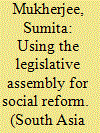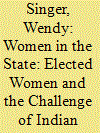| Srl | Item |
| 1 |
ID:
076317


|
|
|
|
|
| Publication |
2006.
|
| Summary/Abstract |
In 1929, the Legislative Assembly of India, a body of representative Indian politicians, passed a law making the minimum age of marriage 14 years for girls. In contrast to the debates in the 1890s from which the 1891 Age of Consent Act was passed by the imperial legislature, there were intense debates in 1920s India involving British and Indian social reformers on the issue of marriage. Marriage affected the majority of the population and involved all communities, and this was the first legislation to impose a minimum age. Child marriage was seen in the eyes of some Indians and outsiders as an outdated and particularly harmful tradition, but many Hindus justified the practice as a religious necessity. The article explores how Indian reformers were able to defy opposition and use the new governing mechanisms given to them to pass legislation on a matter of national concern.
|
|
|
|
|
|
|
|
|
|
|
|
|
|
|
|
| 2 |
ID:
178863


|
|
|
|
|
| Summary/Abstract |
When Parvathi Krishnan (MP, Coimbatore Madras) entered India’s parliament on 28 March 1958, it was just a regular workday. She questioned a government minister about his policies toward railway workers, and solicited funds to repair a post office in her constituency. And yet as a woman legislator, she balanced the everyday tasks of governance with the difficulties of functioning in a male-centred institution. This essay, based on research in legislative debates in Madras and Bihar as well as in parliament, argues that especially for the period from 1957 to 1962, when so much of the legislative process was still in flux, women legislators challenged government structures even as they participated in making them. Their work—for the state and for their constituents—necessarily shaped the institutions to which they were elected. Looking beyond high-profile policies like the Five-Year Plans, this essay reveals the complex task of governing and the critical roles of women in it.
|
|
|
|
|
|
|
|
|
|
|
|
|
|
|
|